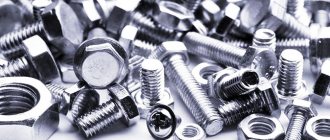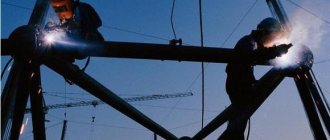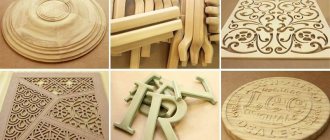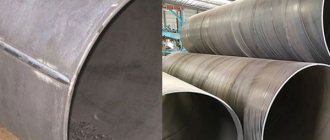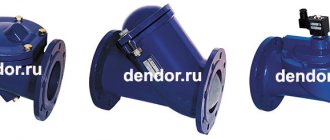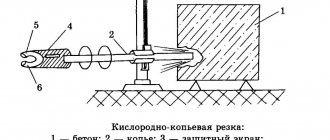12/15/2021 Author: VT-METALL
From this material you will learn:
- Differences between manual and orbital pipe welding
- Applications of orbital welding
- Advantages and disadvantages of orbital welding
- Orbital Welding Equipment Components
- Orbital welding requirements and equipment setup
Orbital welding is used to connect large and small diameter pipes in various industrial and commercial areas. Welding occurs automatically; special attachments are used for this. The wizard only sets parameters and controls the process.
Compared to the manual welding method, orbital welding allows you to reduce the percentage of defects to a minimum, speed up the completion of work, and achieve maximum quality of workmanship. You will learn about what equipment is used for orbital welding and how the process itself works from our material.
Differences between manual and orbital pipe welding
The irrevocable butt weld type is the most complex type of welded connection for pipes of any diameter. To simply connect two pipes, it is enough to have welding skills in any spatial position, which most often only possess highly qualified craftsmen. Many novice welders, when forming the top of a weld, think that the rest of it will be as simple as the beginning. In fact, this is not always the case.
VT-metall offers services:
After the top, the side vertical joints are welded, which is much more difficult. And the process ends by making a ceiling seam on the bottom of the pipe. Such an operation is not an easy task for beginners with insufficient experience.
The main differences between automatic orbital welding and manual welding are as follows:
- the orbital head can be rotated around the workpiece at an angle of up to 360°;
- technological equipment of the process with modern numerical control systems makes it possible to minimize the involvement of operator manual labor;
- most often (in 9 cases out of 10) tungsten electrodes are used.
The effectiveness of orbital welding largely depends on the purity of the argon used. For example, for welding work under normal factory conditions, gas with a purity of up to 99.95% is used, and for joining stainless pipes using orbital welding, in some cases ultra-high purity argon is required, the value of which can reach 99.9998%.
Automatic orbital installation KHGC
A unique automatic orbital installation KHGC (China) for welding pipes of various diameters both in a welding shop and during installation work.
The KHGC automatic orbital installation can be widely used in the nuclear industry, turbine industry, shipbuilding, gas pipeline installation, as well as steam and hot water pipelines, and even in the food industry.
The KHGC automatic orbital machine is designed for closed type argon arc welding (TIG) without filler wire. The machine can be used for welding carbon steels, low-alloy steels, high-alloy steels, high-chromium steels, as well as for welding non-ferrous metals and alloys.
The unique characteristics of the KHGC automatic orbital installation make it possible to easily weld fixed joints of pipes of various diameters depending on the modification (6 models to choose from) of the welding head with a diameter from 3 mm to 180 mm with a wall thickness from 0.8 mm to 3.0 mm. Portable units have a small weight, which makes them very mobile, which allows them to be used in installation conditions.
The KHGC automatic orbital installation is indispensable for welding fixed joints of pipelines, as well as for welding various elements that are widely used in the construction of pipelines, including flanges, various bends to pipes, as well as fittings and pipes.
The closed-type welding heads of the KHGC automatic orbital installation have proven themselves to be excellent in welding tube sheets. Welding with the KHGC orbital unit makes it possible to perform welding work in a closed space, which avoids the harmful effects of an open arc on humans, such as infrared and ultraviolet radiation.
As mentioned above, the automatic orbital installation has low weight and small overall dimensions of all equipment: power supply, operating system, welding head itself, as well as water and air cooling systems, which helps to carry out welding work even in a narrow space. Welding occurs without flanging edges and without tack welding, which avoids unnecessary heating of the metal. The switching power supply ensures a high-quality weld. Due to the fact that the welding head is equipped with a gear system, its rotation occurs very smoothly and evenly. It is very important that the operating system can save up to 100 welding modes. A unique feature of the installation allows you to read and print all technical information about the weld, in fact, make a passport of the weld right during welding. The unit is equipped with a touch screen.
A reliable and fairly easy-to-use automatic orbital installation KHGC will serve you for many years, while reducing your economic costs due to filler-free welding technology.
- Large selection of welding heads for welding various pipe diameters.
- The completely enclosed head avoids harmful influences.
- The small size and weight of the installation allow it to be used during installation and in a narrow spatial position.
- Smooth and uniform rotation of the welding head allows you to produce a high-quality weld.
- The ability to record the actual welding mode during the welding process and print it on a printer.
source
Applications of orbital welding
Equipping with special equipment allows you to perform all the work automatically; the welder’s task is only to set the necessary settings and monitor the progress of the process. In addition, the supply of shielding gas and filler wire to the welding zone is also carried out automatically. In simple terms, the orbital welding method is very similar to semi-automatic welding, only the specialist does not have a primary role in the process, and the movement of the torch can be carried out along a circular path.
Automatic orbital welding of pipe joints is used in the following technologies:
- carrying out work on linear installation of pipelines;
- fastening flange connections;
- connection of bends, tees and other pipe fittings with sections of rolled pipe;
- welding heat exchangers from pipes.
The use of orbital pipeline welding installations leads to minimization of defects, increased productivity when laying pipelines, assembling boilers and installing heat exchangers. In addition, the maintenance and repair of thermal power plants, utilities, and gas mains and oil pipelines is greatly simplified.
Features of the type of welding
Equipment for permanently connecting fixed pipe joints has the ability to rotate around a metal product, while the product itself is stationary. That's why the method got its name. The rotation of the device causes some effect on the weld pool, which requires a timely change in the set parameters. Most often, orbital welding of pipes is applicable when installing pipelines in limited conditions, where either the welder does not have the opportunity to sit comfortably, or the free space does not allow placing bulky equipment.
The basic segment of all work is arc welding with non-consumable electrodes in an inert gas environment. The most famous mixtures are argon with hydrogen, or with helium, or pure argon. Depending on the ratio of components, it is possible to increase the speed of welding of workpieces, increase the penetration depth or minimize the amount of splashes on the surface.
Welding equipment for orbital welding resembles a argon arc machine, but has increased productivity and power.
Advantages and disadvantages of orbital welding
Today, the popularity of using orbital welding installations is increasing every year. The reason for this is certainly due to the following special advantages:
- The technology allows you to achieve high productivity without compromising efficiency and quality.
- The welding process can be performed either with or without filler materials.
- The orbital welding method almost eliminates slag and fumes harmful to the human body. Thanks to this, the negative impact on the welder is minimized.
- Welding parameters are controlled automatically. In other words, the welder-operator only sets the necessary settings, and the operating mode is supported by the equipment.
- The correct choice of welding carriage model in combination with the complex will allow you to join any metals, including steel and even titanium, without any problems. With certain skills and experience, a welder will be able to weld brass or bronze workpieces.
- The process of applying a seam can be performed from any spatial position.
- The technological effectiveness of the process allows us to ensure a fairly low percentage of defects. Since the part is processed according to a given algorithm, and the human factor is reduced to zero, the result is high-quality welded joints.
The orbital welding method, like any other method of joining parts, has its disadvantages, among which are:
- Quite a high cost of equipment.
- Complex maintenance and repair of equipment.
- Quite low processing speed of thin-walled pipelines (depending on the type of orbital head used).
Advantages
Orbital welding of large pipes
Automated welding mode provides a high level of productivity.
Having set the settings for one mechanism, the specialist can begin setting up the next one while the first one is doing the work. Or prepare the following details.
An unobvious advantage of orbital welding is mass production. This works when pipes of the same diameter are welded.
Having set up the device at the beginning, you can let the parts flow. Automation of production also eliminates the human factor, producing a consistently high level of welding.
Orbital Welding Equipment Components
An orbital welding machine is a combination of three large units: a gas supply system, a welding current source, and in addition, welding “heads” are used. The gas supply system is the same as in any semi-automatic equipment. And it’s worth saying a little more about the current source and welding head.
The current source is an inverter capable of delivering from 30 to 400 amperes, near which a gas cylinder is placed. The inverter has a programmable control panel. In addition, there are models equipped with remote control. The housing provides for the installation of a printer that produces a printout on a form with the technical results of the work performed.
To set up orbital welding equipment, you need to set the following parameters: wall thickness and pipe diameter, required volume of gas, inclination angle and speed of electrode movement, filler wire feed speed, welding current and voltage.
There are several types of welding heads that can be used to weld metals up to 170 mm thick. They, in turn, are divided into three main groups:
- Open version. This type of orbital welding head is used when joining thick-walled pipes when it is necessary to perform multiple repetitions of the cycle. Their advantage is the operator's ability to control the arc length throughout the entire process.
- Closed type. The orbital welding process takes place in closed chambers, which are filled with inert gas to completely protect all elements. A high level of reliability is their main advantage. Even from partial depressurization of the joint, the quality of the welded joint will not deteriorate, since oxygen will not be able to penetrate inside.
- For tube sheets. This type of orbital welding is used for the restoration of heat exchangers consisting of many elements. The process makes it possible to significantly simplify the connection of parts, while simultaneously reducing the impact of the human factor.
To weld pipes of a certain diameter, the appropriate types of heads must be used. For example, to weld metal with a diameter in the ranges from 10 to 170, from 33 to 90 and from 17 to 50 mm, a tool of the RKV and RKS type should be used.
Orbital welding of small diameter pipes is high-speed and does not require additional equipment. While for connecting large-sized pipes, special brackets will be required to move the welding head for orbital welding along them. The trajectory of the head movement is also programmable; correction of all settings can be done during operation, including using remote control. To achieve maximum weld quality when welding large-diameter pipes, you can additionally change the position of the electrode.
Operating rules
Now a few words about process control. When orbital welding, it is necessary to monitor a number of parameters, as well as carry out a little preparatory work. In particular:
- the gap between the workpieces does not exceed 5% of the pipe thickness, otherwise the quality of the seam will deteriorate;
- a similar deviation is permissible in relation to the wall thickness in the welding area;
- prepare and use clamps and stands that allow you to line up two pipes side by side.
The wide range of orbital welding capabilities has made it popular in mechanical engineering, electrical engineering, food industry, shipbuilding, aerospace, and pharmaceuticals. The automated process is in demand during the construction of thermal power plants and combined heat and power plants. Expensive equipment costing about a million rubles is used here. To work with small-diameter pipes, it is enough to purchase a removable head for no more than a few hundred rubles.
If you know the nuances of working with equipment for orbital welding or other features of the issue, share your experience in the discussion for the article.
Orbital welding requirements and equipment setup
When preparing surfaces for welding, the alignment of the end surfaces is performed on cutting machines, which make it possible to ensure an even vertical edge. Processing of thick-walled pipes is carried out in the factory: after cutting the edges, a chamfer is made at an angle of 30°. Rolled products with thin walls should be melted without using an additive.
Recommended articles
- Types of welds: we understand the classification and features
- Production of metal products: technologies, advantages, step-by-step control
- Fusion welding: where it is used and how it is produced
There is no specific GOST that would fully describe the entire orbital welding technology. But the provisions of the following documents can be partially used in practice:
- GOST 10157-79. Argon gaseous and liquid. The technical conditions of use are listed.
- GOST R ISO 857-1-2009. Welding and related processes. A description of welding processes is given and basic definitions and terms are given.
- GOST 6996-66. Welded joints. It presents data on methods for determining mechanical parameters.
- GOST 16037-80. Welded connections of steel pipelines. Contains information about the main types, structural elements and dimensions.
Before orbital welding of pipes, it is necessary to prepare the surfaces. First, the ends are cleaned of dirt and burrs. After this, the prepared workpieces should be centered and placed, maintaining the required gap between them.
To perform orbital welding of small diameter pipes, it is enough to have a removable head, securing it to universal clamping devices. The joint surface should be divided into sectors, for each individual parameters should be set, taking into account the pressure of the workpiece’s own mass in the lower area. Do not allow the molten metal to sag on top.
The choice of parameters for the filler rod feed rate and working current is made by the welding operator independently, based on the grade of steel being processed and the geometric shape of the part. The orbital welding machine is attached in the area of the butt part of the joint.
The process of orbital welding of stainless pipes is performed by the operator in the following sequence:
- setting up the orbital system;
- selection and installation of the appropriate type of orbital head;
- securing the apparatus along the line of the planned weld;
- turning on the welding equipment.
If the installation is completed correctly, the welding machine itself will perform the following actions:
- will reach the mode by warming up the electrode;
- will create a seam section in the first sector of the workpieces being welded;
- will continue connecting stainless steel pipes in the remaining sectors.
The process of orbital metal welding is performed automatically. When all sectors are closed, the device will turn off on its own.
The orbital type of equipment is highly specialized. It is used for repairing boilers and heat exchangers, as well as for connecting long-distance pipelines. The technology of orbital welding of stainless pipes as a method of installing rolled pipes is one of the most promising. In everyday life, the use of such a device is impractical due to the long payback period.
Preparation of joints
To begin with, it is worth understanding that this method most often does not allow welding to be carried out on the inside of the seam. As a result, the connection is made on a specific application ring. But the conditions in which the pipeline design is used often do not make it possible to reduce the pipe flow area. This means that it is worth using edge cutting if we are talking about joining workpieces with a material thickness of over 3 mm.
In order for the weld to be of the highest quality, you must adhere to the following rules when preparing the surface for orbital welding:
- the plane must be perfectly clean;
- it is necessary to maintain the perpendicularity of the joint surface relative to the axis of the pipe;
- when cutting there should be no burr;
- The accuracy of the gap must be maintained during the assembly of joints for the connection;
- not edge preparation parts, minimum tolerances possible.

